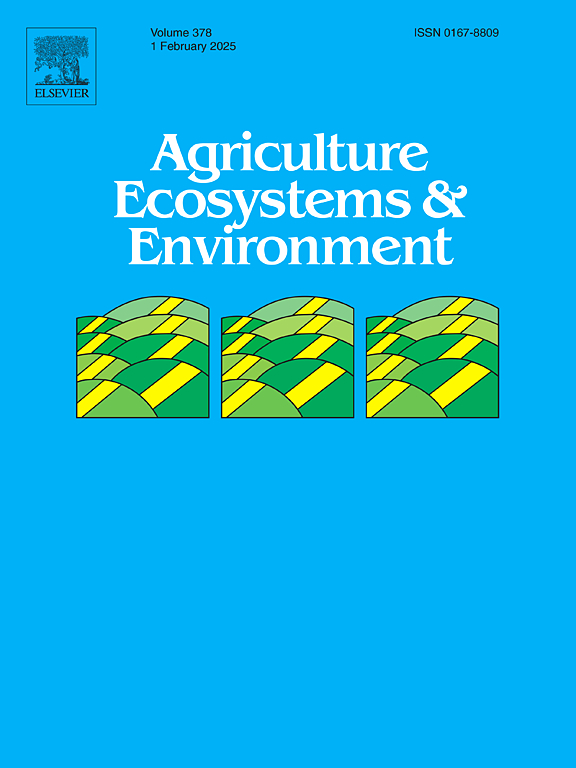Are dual inhibitors superior to urease or nitrification inhibitors for mitigating environmental risk and enhancing agronomic efficiency?
IF 6
1区 农林科学
Q1 AGRICULTURE, MULTIDISCIPLINARY
引用次数: 0
Abstract
Enhanced-efficiency fertilisers are recognised methods of mitigating reactive nitrogen (Nr) release. Although previous data-driven studies have assessed the reductions in Nr emissions and increases in crop production and N utilisation from using urease inhibitors (UIs) and nitrification inhibitors (NIs), they have not determined whether dual inhibitors (DIs) outperform single inhibitors or identified the factors driving their efficacy. Therefore, we adopted a method that combines meta-analysis with a machine-learning model to determine the efficacy of DIs for emissions control and agronomic efficiency, clarify any differences with UIs or NIs, and identify the primary drivers. The results show that compared to urea, DI amendment significantly reduced NH3 volatilisation and N2O, NO, and CH4 emissions by 47.0 %, 36.9 %, 65.3 %, and 51.0 %, respectively, while increasing crop yield, N uptake, and N use efficiency by 5.6 %, 7.2 %, and 29.3 %, respectively. Moreover, its efficacy was mainly determined by soil pH and soil organic carbon. Compared with the UI alone, the DI significantly increased NH3 volatilisation, yield, and N uptake by 19.8 %, 2.0 % and 2.2 %, respectively, and decreased N2O and NO emissions by 23.9 % and 46.0 %, respectively. Compared with the NI alone, the DI significantly decreased NH3 volatilisation by 46.5 % and increased N2O emission, crop yield, NUE, and N uptake by 9.2 %, 2.6 %, 8.0 %, and 5.2 %, respectively. These results underscore the ability of DI-based fertiliser to mitigate environmental risks and enhance agronomic efficiency and revealed suitable application practices for avoiding the trade-offs associated with a single inhibitor. This study provides suggestions for the selection of mitigation options and promotes sustainable N management in the crop production sector.
在减轻环境风险和提高农艺效率方面,双重抑制剂是否优于脲酶或硝化抑制剂?
增效肥料是公认的减少活性氮(Nr)释放的方法。虽然以前的数据驱动研究已经评估了使用脲酶抑制剂(UIs)和硝化抑制剂(NIs)减少了Nr排放,增加了作物产量和氮利用率,但它们并没有确定双重抑制剂(DIs)是否优于单一抑制剂,也没有确定驱动其效果的因素。因此,我们采用了一种将荟萃分析与机器学习模型相结合的方法来确定DIs对排放控制和农艺效率的功效,澄清与ui或NIs的任何差异,并确定主要驱动因素。结果表明,与尿素相比,DI改性显著降低了NH3挥发量、N2O、NO和CH4排放量,分别降低了47.0% %、36.9% %、65.3% %和51.0% %,提高了作物产量、氮吸收和氮利用效率,分别提高了5.6% %、7.2% %和29.3% %。其有效性主要受土壤pH值和土壤有机碳的影响。与单独施肥相比,DI显著提高了NH3挥发量、产量和N吸收率,分别提高了19.8 %、2.0 %和2.2 %,N2O和NO排放量分别降低了23.9 %和46.0 %。与单独施用NI相比,DI显著降低了NH3挥发量46.5% %,增加了N2O排放、作物产量、氮肥利用率和氮吸收,分别提高了9.2% %、2.6 %、8.0 %和5.2 %。这些结果强调了基于di的肥料减轻环境风险和提高农艺效率的能力,并揭示了适当的应用实践,以避免与单一抑制剂相关的权衡。本研究为缓解方案的选择提供了建议,并促进了作物生产部门氮的可持续管理。
本文章由计算机程序翻译,如有差异,请以英文原文为准。
求助全文
约1分钟内获得全文
求助全文
来源期刊

Agriculture, Ecosystems & Environment
环境科学-环境科学
CiteScore
11.70
自引率
9.10%
发文量
392
审稿时长
26 days
期刊介绍:
Agriculture, Ecosystems and Environment publishes scientific articles dealing with the interface between agroecosystems and the natural environment, specifically how agriculture influences the environment and how changes in that environment impact agroecosystems. Preference is given to papers from experimental and observational research at the field, system or landscape level, from studies that enhance our understanding of processes using data-based biophysical modelling, and papers that bridge scientific disciplines and integrate knowledge. All papers should be placed in an international or wide comparative context.
 求助内容:
求助内容: 应助结果提醒方式:
应助结果提醒方式:


